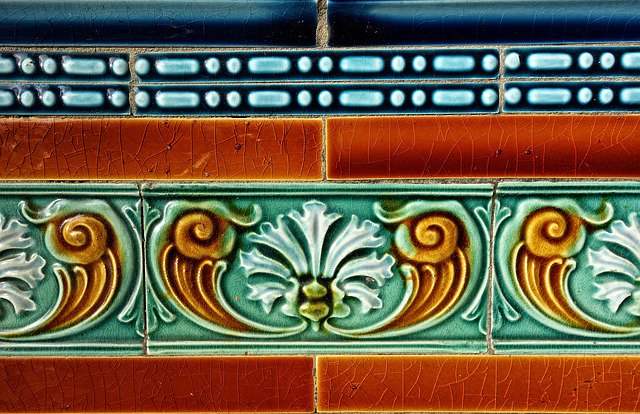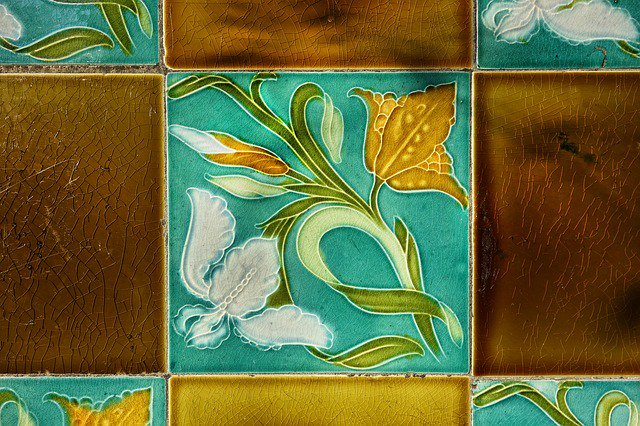Tiles are used in the kitchen and bathroom. But they are also more and more often laid on the floors in the living area, because they are perfect for underfloor heating. Read in this article why ceramics and natural stone especially contribute to a pleasant living environment, how to keep your tiles in good shape and what format makes sense.
the essentials in brief
- Before choosing a floor covering, you should consider what influences the floor will be exposed to.
- Tiles are available not only in common materials such as ceramic and terracotta. There are also carpet and PVC tiles, which are a good alternative to rolled flooring.
- Replacing the tiles is inevitable at some point, but surprisingly simple.
Floor tiles
Tile flooring is classic and timeless. Tile floors are also hard to beat in terms of cleaning and maintenance. In addition, tiles are robust and durable.
Whether it’s planks, carpet or tile, before you choose a material, you should be aware of the stresses your floor will be exposed to.
- In which room is the floor located?
- Is it exposed to moisture?
- Is it entered barefoot or with street shoes?
- How slip resistant should it be?
- Are there children in the house?
Because: Due to the density and hardness of the material, impacts on the floor can hurt more than it is, for example, on a wooden floor. Stoneware or porcelain stoneware tiles are particularly suitable for floors, as they generally withstand higher loads than wall tiles. Since tile floors get uncomfortably cold in the winter, underfloor heating makes sense. In general, tiles should be slip-resistant, especially when walked on without footwear. Small tiles have the advantage of having many joints and therefore are basically more slip resistant. This also applies to unglazed flooring. (We have compiled tips on interior design in our article How to succeed in healthy and environmentally friendly interior design ).
Wall tiles
Wall tiles are chosen as a lining to protect walls from moisture, heat, grease (in the kitchen). Again, think about what stains to expect beforehand: for example, different dirt buildup in the kitchen, bathroom or living room. Also, should the tiles be acid, moisture or frost resistant? Select the material according to these aspects.
In principle, glazed ceramic tiles are suitable for interior use. They are comparatively easy to cut to size and can withstand the drilling of holes. They resist germs and fumes and are therefore more durable than wallpaper.
Mosaic tiles
Traditionally, shapes of various sizes are cut out of large clay slabs, colorfully painted, glazed and assembled into a pattern. Mosaic tiles can be square, rectangular, octagonal or round. So as individual as the pattern can be, the tile can also be individually shaped. The tiles are now industrially manufactured from ceramic, glass or natural stone and offered as a prefabricated panel.
This makes it easier to lay the small elements. However, it is precisely this smallness that allows it to be laid on rounded or uneven surfaces. The many joints also make this flooring more slip resistant than floors covered with large format tiles. (Find more inspiration for your dream home here).
Tile borders
To break up a monotonous white tile wall, you can create small interruptions with the help of tile borders. These do not correspond in height to the format of the actual tile and thus draw the eye. A great opportunity to break up the homogeneity of the tiled wall with a special, thoughtful accent! However, the element can also be used as a termination of a wall. It makes sense to keep the material of the tiles. However, there are no limits to the choice of pattern. If the border is out of date or no longer like it after a while, it can be easily replaced and replaced with another border or simply a white tile.

Ceramic tiles
It is widely known that tiles were used thousands of years ago in the Orient to cover walls and floors. In Europe, we know this tradition from the Middle Ages. With tiles, fired from clay, were equipped mainly churches and monasteries. In the firing technique, to this day, the higher the temperature, the harder and more resistant the tile! Often individual pieces were offset with ornaments. This is also what we still find today – especially on walls. Whether fruit or vegetable motifs in the kitchen, subtle patterns in the bathroom or old heirloom ceramics on tiled stoves: this brings accents to what might otherwise be a monotonous tiled wall.
Ceramic tiles are often made from clay and sand. Depending on the intended use, the product is fine-grained or coarse-grained. Coarse-grained tiles are suitable for floors in all rooms except bathrooms. In bathrooms, as a rule, laid fine-grained tiles.
Terracotta

Terracotta is the name given to unglazed, coarse-grained stoneware tiles. Large living areas can benefit from a floor made of terracotta, as the material’s rough surface dampens reverberations and creates a cozy living atmosphere alongside the natural red tones.
Natural stone tiles
A natural stone tile can be up to 12mm thick and is mainly used for outdoor floors such as terraces, but also window sills and bathrooms. Limestone, sandstone, but also the high-maintenance marble, are the most common materials in private use.
Self-adhesive tiles
Tiles are available on the market in a wide variety of looks. Even for tiles rather non-traditional materials such as carpet or PVC can be made into a practical rectangular or square shape as individual parts and easily laid and replaced as needed.
As an alternative to PVC rolled floor covering can be used self-adhesive tiles made of vinyl. This type of floor and wall covering is particularly easy to handle and can be installed effortlessly by the layman. The PVC is easy to clean and is therefore particularly suitable when a room needs to be spruced up quickly and also requires no effort in ongoing maintenance. Another plus point is also the comparatively low price.
However, self-adhesive tiles, unfortunately, you can quickly see their inferior material. Unfortunately, the room atmosphere and temperature that a ceramic or natural stone tile creates cannot be provided by a vinyl floor either.
Carpet tiles
Carpet tiles are a good alternative to the classic carpet. This type of floor design made of individual elements – just tiles – between 40cm x 40cm and 1 m x 1 m has the advantage of being able to be applied piece by piece and also replaced if necessary. So feel free to include an extra pair of carpet tiles! Shades can be varied for that special effect. The tiles are easy to transport and can be taken back with you the next time you move!
Glass tiles
Glass tiles are also easy to install and can be replaced piece by piece. With glass, there is an additional puzzle effect that is not present in a simple mirror wall. Attention: The glass tile backsplash requires frequent maintenance, as lime and grease are particularly visible there.
Laying tiles
For the durability of the tile, the quality of the material and workmanship is particularly important. But even when laying should already pay attention to good conditions. The substrate should be dust-free, load-bearing and made of sound mortar. Laying can begin after all interior plastering , carpentry and locksmith work is completed.
Also, pay attention to the influences to which the tile will be exposed. For example, if it is a terrace floor, it will have to withstand rain, snow and sun. Bathroom floors and walls are also exposed to special influences, especially moisture and possible mold growth. So, when choosing a material for tiles and grout should take into account all points of view. Consider whether you can (or want to) do the tiling yourself, or whether it may be cheaper to hire a professional company to do it. (How much personal contribution do you want to make when building the house? You can find information about finishing stages in our article Turnkey, ready for technical installation or ready for finishing – what does it mean).
Cleaning and restoration? Or is tile replacement inevitable at some point?
Cracks in the glaze are almost impossible to avoid after prolonged use. When the temperature changes, the material of the tile (shard) and the coating (glaze) expand differently, causing the tiles to crack in places. In manufacturing, it is difficult to find a match between the two materials, so the shard and glaze react differently to temperature. Of course, the better the quality, the more resistant the product.

When cracks in the glaze come into contact with impure substances – and this is inevitable – discoloration also occurs. This is the time when you surely ask yourself the question: What is worthwhile? Clean? Paint? Or replace it right away?
Tile cleaning
Glazed tiles in particular are usually easy to clean. The addition of conventional dishwashing detergent is quite sufficient to remove simple soiling. Lye-based cleaners are especially recommended because they also do not attack the joints.
Outdoor tiles can be maintained with special solutions made of resins. With regular use, they can well maintain the flooring.
Mold in the joints is rarely dangerous for the people who do not have allergies. However, this one is still not pretty. Clean the fungus with methylated spirits or rubbing alcohol. Alternatively, you can use mold cleaner with or without chlorine. If it is an infested silicone joint, unfortunately, you can no longer do much with cleaning agents and should have it replaced. Be sure to wear gloves when cleaning, rinse with water after exposure and ventilate the room extensively!
Paint tiles
If the tile is already affected by cracks, the only solution is to restore or renew it.
Before painting, the tiles should be at least free of lint and grease, it is best to clean them with vinegar beforehand. Then they should be roughened with sandpaper. After this can be primed, followed by two coats of tile paint. It is recommended to allow a drying time of approx. 12 hours between each coat.
Painting the tiles is recommended not only in case of severe damage. Tiles that have been with you through life for a while and are out of date in color will certainly look modern and like new again in a simple white!
Replace tiles
If the damage is so massive that no amount of paint can cover it, or if a surface has been extensively infested with mold, there is only one thing that can help: replace it. For this purpose, the mortar must first be removed with a joint knife; in the case of a silicone joint, a cutter knife will help. The tile can be knocked off classically with a hammer and chisel. Here you can work from the center to the edges. The tile must be completely removed and the substrate must be dust-free and free of shards again. An uneven substrate can be leveled with mortar. Only then can begin the installation of a new tile and grouting. (Let your creativity run wild when designing your own furniture with our tips on upcycling wood ).
How big do the tiles need to be? What format should they have?
There are no national or international standards in the field of tile size. Often, the individual elements are found in a convenient square format. Bridges and edges can be rectangular or triangular. But: there are also polygonal and round tiles, tiny and oversized pieces. Here there are no limits to the imagination and taste. Here are a few suggestions:
- Very small parts are very suitable for small areas. On the other hand, in a large room – like living and dining area – they can look lost. In addition, they can spread some unrest, stealing the show from the furniture.

In general, small tiles are more slip-resistant and therefore safer and are therefore super suitable for the (smaller) bathroom, or as a covering for the shower!
- Fixtures, furniture, edges and height differences in the room should be coordinated with the transitions of the tiles
- rectangular instead of square tiles can give direction to the room, make it wider or narrower
- Especially diagonally laid tiles make the room look disharmonious, but also exciting
Conclusion
Since tiles make walls and floors resistant to dirt and moisture, respectively, they are extremely easy to clean, they are used in bathrooms and kitchens. In the Mediterranean region, however, tiles have always been present in the living area. And in this country, too, tiles are being installed more and more often in the living room. If there is underfloor heating, the tiles are also always nice and warm. The choice of the type and color of the tiles also contributes a lot to the atmosphere of the home. Builders should therefore consider choosing tiles instead of parquet or carpet. This definitely brings advantages: they are both easy to clean and robust, as well as easy to replace. However, those who have children in the house, should also remember that a tile floor is very hard and slippery.


